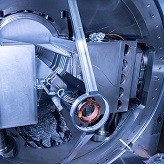New experiments at CERN

 © 2020 CERN, Noemi Caraban Gonzalez
© 2020 CERN, Noemi Caraban Gonzalez
Heavy ion physics is a fundamental area of physics explored by two teams at the Leprince Ringuet Laboratory (LLR*): the CMS team, which will soon welcome Leticia Cunqueiro, and the LHCb team which is also working on the understanding of the quarks and gluons plasma produced in ultra-relativistic heavy ion collisions.
What is the difference between these two experiments? The energy of the collision.
Indeed, on CMS, it is two accelerated heavy ions that collide face to face. The energy is very high and the quark-gluon plasma produced, strongly coupled and very hot, is the seat of several complex phenomena that must be successfully decorrelated to understand the strong interaction at high temperature.
In the case of LHCb, thanks to the SMOG2 gas target installed this summer, the LLR team will study collision data between heavy ions and "slow" atoms injected at the interaction point of the experiment. "We are using the same principle as the experiments that could be carried out with the first gas pedals, with much less energy, but this time with the latest technologies to understand what happens at low energy in the quark-gluon plasma," explains Frédéric Fleuret, CNRS research director at the LLR.
Indeed, "the advantage of having less energy is that the plasma produced by the collision is less complex" adds Emilie Maurice, assistant professor at the LLR. "This will allow us to characterize certain phenomena independently of each other".
By testing with LHCb mechanisms within the plasma such as "color scrambling", a phenomenon predicted by theory but not yet precisely characterized, the researchers will be able to feed the decoding of data from experiments where the mechanisms at play in the plasma are more complex, as is the case on CMS. These experiments are complementary, mutually enriching each other to allow researchers to improve our knowledge of the laws of Nature.
Learn more about the SMOG2 target
Here, "gaseous target" does not mean that a gas as we are used to, such as air, is blown into the experiment. The collisions take place under a vacuum of 10-9 mbar and injecting air would have dramatic consequences on the material. The injected gases, mainly noble gases (Helium, Neon, Argon), will be injected at a pressure of 10-6 mbar, so some atoms will diffuse and collide with the heavy ion beam. This principle has been tested before the installation of the target during a phase of measurement of the beam performance with the LHCb experiment and showed that it was possible to make beautiful physics with this type of injection. The first experiments should start in a few months and thus demonstrate their interest in understanding the plasma of quarks and gluons.
*LLR, a joint research unit CNRS-IN2P3 / École polytechnique - Institut Polytechnique de Paris
 Support l'X
Support l'X